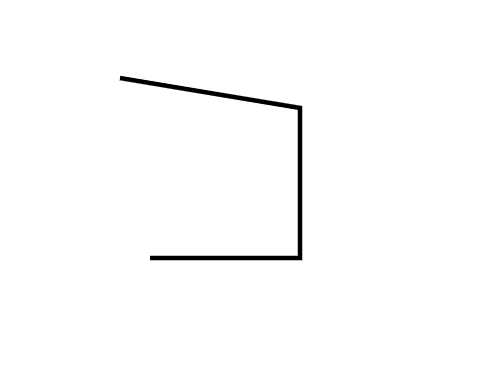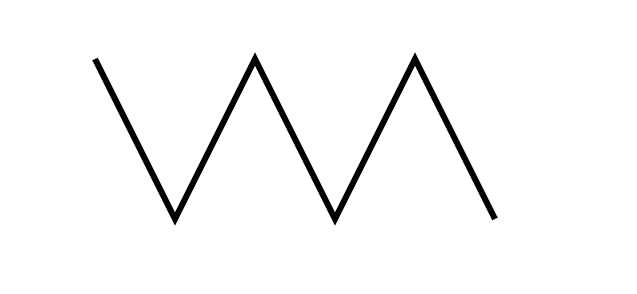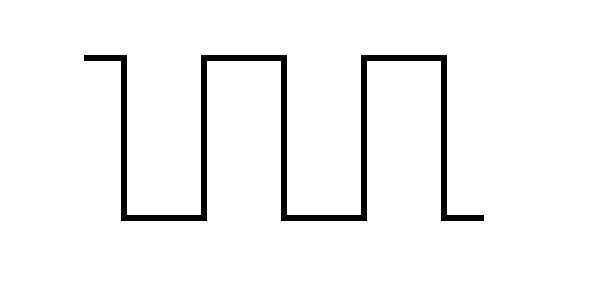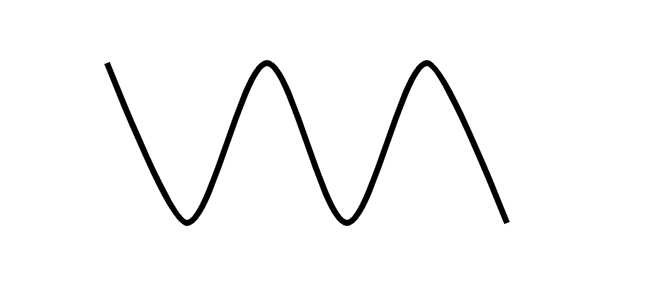标签:接下来 nbsp 保存 data 手动 not stroke function attr
1 function x(d){
2 return d[0] //第一个值是x坐标
3 }
4
5 function y(d){
6 return d[1] //第二个值是y坐标
7 }
1 <line x1="20" y1="20" x2="300" y2="100" />
1 svg.append("line")
2 .attr("x1",20)
3 .attr("y1",20)
4 .attr("x2",300)
5 .attr("y2",100)
1 <path d="M20,20L300,100" />
1 svg.append("path")
2 .attr("d","M20,20L300,100")
1 //创建一个svg画图区域
2 var svg = d3.select("#body")
3 .append("svg")
4 .attr("width",600)
5 .attr("height",400)
6
7 //线段的点数据,每一项是一个点的x和y坐标
8 var lines = [[80,80],[200,100],[200,200],[100,200]]
9 //创建一个线段生成器
10 var linePath = d3.svg.line()
11
12 //添加路径
13 svg.append("path")
14 .attr("d",linePath(lines)) //使用了线段生成器
15 .attr("stroke","black") //线的颜色
16 .attr("stroke-width","3px") //线的宽度
17 .attr("fill","none") //填充颜色为none

1 //创建一个svg画图区域
2 var svg = d3.select("#body")
3 .append("svg")
4 .attr("width",600)
5 .attr("height",400)
6
7
8 var lines = [80,120,160,200,240,280]
9 var linePath = d3.svg.line()
10 .x(function(d){return d})
11 .y(function(d,i){
12 return i%2 == 0? 40 : 120
13 })
14
15 //添加路径
16 svg.append("path")
17 .attr("d",linePath(lines)) //使用了线段生成器
18 .attr("stroke","black") //线的颜色
19 .attr("stroke-width","3px") //线的宽度
20 .attr("fill","none") //填充颜色为none

1 var linePath = d3.svg.line()
2 .interpolate("linear-closed")
1 function interpolateLinear(points){
2 return points.join("L")
3 }
1 //创建一个svg画图区域
2 var svg = d3.select("#body")
3 .append("svg")
4 .attr("width",600)
5 .attr("height",400)
6
7
8 //step插值模式
9 var lines = [80,120,160,200,240,280]
10 var linePath = d3.svg.line()
11 .interpolate("step")
12 .x(function(d){return d})
13 .y(function(d,i){
14 return i%2 == 0? 40 : 120
15 })
16
17
18 //添加路径
19 svg.append("path")
20 .attr("d",linePath(lines)) //使用了线段生成器
21 .attr("stroke","black") //线的颜色
22 .attr("stroke-width","3px") //线的宽度
23 .attr("fill","none") //填充颜色为none

1 //创建一个svg画图区域
2 var svg = d3.select("#body")
3 .append("svg")
4 .attr("width",600)
5 .attr("height",400)
6
7
8 //basis插值模式
9 var lines = [80,120,160,200,240,280]
10 var linePath = d3.svg.line()
11 .interpolate("basis")
12 .x(function(d){return d})
13 .y(function(d,i){
14 return i%2 == 0? 40 : 120
15 })
16
17 //添加路径
18 svg.append("path")
19 .attr("d",linePath(lines)) //使用了线段生成器
20 .attr("stroke","black") //线的颜色
21 .attr("stroke-width","3px") //线的宽度
22 .attr("fill","none") //填充颜色为none

1 //创建一个svg画图区域
2 var svg = d3.select("#body")
3 .append("svg")
4 .attr("width",600)
5 .attr("height",400)
6
7 //cardinal插值模式
8 var lines = [80,120,160,200,240,280]
9 var linePath = d3.svg.line()
10 .interpolate("cardinal")
11 .x(function(d){return d})
12 .y(function(d,i){
13 return i%2 == 0? 40 : 120
14 })
15
16
17 //添加路径
18 svg.append("path")
19 .attr("d",linePath(lines)) //使用了线段生成器
20 .attr("stroke","black") //线的颜色
21 .attr("stroke-width","3px") //线的宽度
22 .attr("fill","none") //填充颜色为none

1 //创建一个svg画图区域
2 var svg = d3.select("#body")
3 .append("svg")
4 .attr("width",600)
5 .attr("height",400)
6
7 //选择性的使用顶点数据
8 var lines = [80,120,160,200,240,280]
9 var linePath = d3.svg.line()
10 .x(function(d){return d})
11 .y(function(d,i){
12 return i%2 == 0 ? 40 : 120
13 })
14 .defined(function(d){
15 return d < 200
16 })
17
18 //添加路径
19 svg.append("path")
20 .attr("d",linePath(lines)) //使用了线段生成器
21 .attr("stroke","black") //线的颜色
22 .attr("stroke-width","3px") //线的宽度
23 .attr("fill","none") //填充颜色为none
效果图 :

标签:接下来 nbsp 保存 data 手动 not stroke function attr
原文地址:https://www.cnblogs.com/littleSpill/p/10850364.html